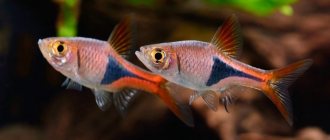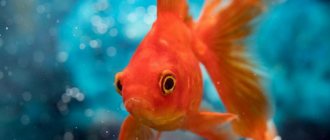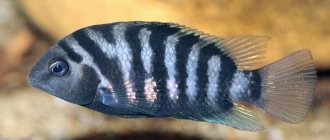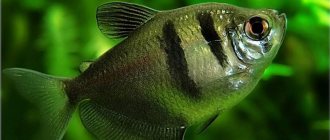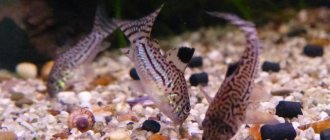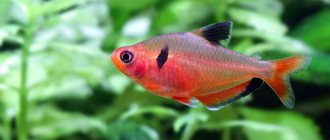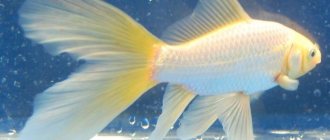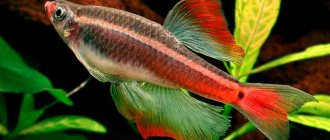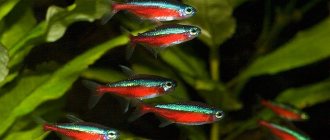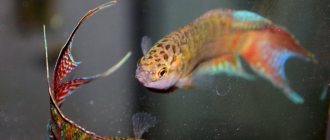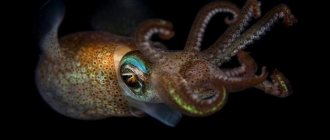General description of the genus
The Rasbora family belongs to the Karpov family. The natural range covers small slow-flowing rivers and shallow lakes of Hindustan, the south-eastern regions of Asia, and the Indonesian archipelago.
When living in nature, the fish stays near the water surface. It feels comfortable in the partial shade of tropical thickets in soft water saturated with humic acids, dark with rotting fallen leaves.
Rasboras are schooling fish, swimming in groups of 12-15 individuals. Therefore, they buy a small flock for the aquarium.
External characteristics common to the genus:
- Graceful, elongated body, flattened laterally;
- Small fins, transparent or translucent;
- Forked caudal fin;
- A small mouth with upward-pointing lips for easy grasping of plankton and insects that have fallen into the water;
- Absence of a mustache near the mouth, typical for most Carp;
- Unpronounced gender differences.
Some species are distinguished by a shortened and rounded body, covered with large scales. The color is individual for each species, but the palette consists mainly of gray and red shades.
How long rasboras live in an aquarium depends on the conditions created, but on average 5 years.
Breeding
The individual becomes sexually mature by 8 months, but it is better to start spawning closer to one year. In about two weeks, the females are removed. By the way, it is better to select males a little younger. For one female, two males are needed.
A container of about 5 liters is suitable as a spawning tank, where 2-3 fish will be quite comfortable. It should first be treated with an antiseptic to avoid undesirable consequences if there were germs and bacteria on the walls. The plants that will be added there must be washed.
It is important that there is a lot of flora in the spawning area, since males are quite aggressive during this period and can rush at their competitors. The water can be melted or distilled. This is necessary due to the fact that it has a low stiffness index. If the water is too soft, it can be diluted with what is in the general aquarium.
It should also be noted that peat is added to the water for spawning. The shade should resemble black tea, but not too concentrated. This is explained by the fact that in nature, water acquires this color due to fallen leaves, which constantly lie there and release various tinting substances.
Interestingly, the sex of future offspring depends on acidity. If the pH is in the range of 5.4-6.3, then there will be 1 female for every 10 fry; if from 6.2 to 6.8, then there will be three of them.
The spawning process itself begins 1-3 days after the parents are transplanted. Feeding stops from this point on, as leftover food can spoil the water.
Lighting should be moderate, and the entire process takes about 2 hours. The males actively pursue the females, and when they squeeze the eggs onto the net (if one has been installed) or plants, they fertilize them. When this happens, the parents are returned to the common aquarium, and the lights are dimmed as the incubation period begins, which lasts 24 hours.
The fry appear after 6 days. From this moment on, the light needs to be strengthened, and it’s time to start feeding the young animals. The diet should consist of nauplii, ciliates, microworms, etc.
Varieties of analysis
Aquarium rasboras are divided into 3 groups according to color, shape and body length: cuneiform rasbora, dwarf, real.
Wedge-spotted
These fish have a wedge-shaped dark spot on both sides of the back of their body.
Representatives differ from other rasboras in their reproduction process: they do not scatter eggs, like other species, but attach them to the leaves of underwater plants.
Wedge-shaped
The most popular type. The wedge-shaped rasbora is also called the heteromorph rasbora, and aquarists nicknamed it harlequin for its bright appearance: a pinkish-silver body decorated with a black wedge, and a red caudal fin. In males the wedge is more distinct, in females it is blurred and rounded. The body is wider and shorter than other rasboras, reaching 5 cm in length.
Hengel
Also called luminous rasbora. The body length of Hengel's rasbora is 3.5 cm. The main color is yellowish-gray, the fins are transparent yellow. A swimming fish appears almost transparent, its scales shimmer softly in good lighting. The back of the body is decorated with a black narrow wedge, above the upper line of which there is a rich yellow stripe.
Espey
The fish has a bright copper color and a silver-gray belly. The back of the body is decorated with a narrow and elongated black wedge of a curved shape. The length of Rasbora Espei is 3.5 cm. For school keeping in an aquarium, at least 8 individuals are required.
Somphongsi
A rare aquarium fish that grows to a maximum of 3 cm, suitable for a nano aquarium. The school should be large, so the fish feel calmer and more confident. The black wedge on the sides is so narrow that it looks more like a stripe.
Dwarf
Small but bright species, the body length of which does not exceed 3 cm.
Measure
Sumatran nanofish do not exceed 2.5 cm in length. Males are brighter in color than females. The body on each side is decorated with an orange longitudinal stripe and an oval black spot. A round spot is noticeable near the anal fin of the Rasbora Mera.
Brigid
The brightest of the dwarf rasboras, endemic to the southwestern reservoirs of Kalimantan. The color is rich red-orange, with a wide black stripe running along the body. The length of the Brigitte's rasbora does not exceed 2 cm. The school hierarchy is interesting: the male with the brightest color becomes the leader.
Firefly
A Thai fish for a small aquarium does not exceed 3 cm in length. The rasbora firefly got its name from its multi-colored iridescent scales. The main color is transparent orange, there is a black stripe along the body, and the base of the caudal fin is decorated with a dark spot. The species is distinguished by aggressive behavior during spawning; to prevent conflicts, spawning individuals are placed in a spacious spawning tank.
Spotted
The fish, up to 2.5 cm long, differs from its relatives in its spotted color. The main color is orange, the sides are decorated with large black spots, small spots are visible near the caudal and anal fins. Rasbora spotted is the most beautiful species in the dwarf group.
Kubotai
Also called green neon rasbora. Body length 2 cm. Scales are silvery-green, iridescent, fins are almost transparent. Microrasbora kubotai is a peaceful fish, not capricious in keeping and feeding, suitable for an inexperienced aquarist.
Galaxy
At first, the fish living in the high mountain reservoirs of Myanmar was considered rasbora. Today it is known that the species belongs to zebrafish, but the usual name has not been changed. The body length of the microrasbora galaxy is 3 cm. The color is very beautiful: the main color is gray-blue, the body is strewn with white specks, the fins are red and black.
Real
Larger dissections. Most species have thin stripes running along the body. The sides are decorated with spots of different shapes and sizes.
Red-tailed
The most popular variety among real rasboras. It is distinguished by a bright greenish-yellow color, with a deep red spot on the tail. Body length is 5 cm. The red-tailed rasbora is timid and feels more confident in a flock consisting mainly of females. The species is easy to care for, less painful than other rasboras, reacts to water pollution, and in its natural environment even inhabits urban ditches and rice plantations.
Three-line
A notable feature in the description of the appearance of the trilinear rasbora is a pattern that visually dissects the caudal fin, which is a continuation of the dark stripe running along the body. Wide transverse stripes are visible on the upper and lower halves of the fin. The main color is silver with an olive tint. At home, the fish grows up to 10 cm, so a school needs a tank of 200 liters or more.
Redback
The dorsal and caudal fin of the silvery Thai fish are decorated with crimson-red spots. Body length is up to 3 cm. The flock prefers to stay in the middle layer of water.
Einthoven
A large representative of rasboras, reaching 10 cm. The fish are silvery, but males differ from females in color. How to determine gender: males have reddish scales, females have greenish scales. A black stripe stretches from the mouth to the caudal fin.
Clown
The rasbora aquarium fish got its name from its bright orange scales with a pink tint. Each side is decorated with two dark spots: a smaller one closer to the head, a larger one closer to the tail. The fish grows up to 5 cm and is distinguished by its lively and fearless behavior.
Two-lane
The peculiarity of the color of the fish with a light silver body and transparent lemon fins is a black stripe, longitudinally divided in two. Body length up to 13 cm.
Mesh
Also called volcanic rasbora because it was first discovered in the volcanic region of western Sumatra. The scales of the fish, reaching 6 cm in length, are edged in a dark color, which gives the impression that a fine mesh has been thrown over the body.
Best neighbors
Rasbora heteromorpha is a peaceful and friendly fish; no special conditions need to be created to keep it. She easily gets along with many types of fish. Excellent neighbors for heteromorphs can be:
different types of tetras
pristellas
erythrozonus
black neons
neons
It is important that the heteromorph is considered a fairly small fish. Therefore, you should not put it in the same aquarium with predatory and large fish, for which it will become food. Under no circumstances should you house a rasbor with black pacu, piranhas, or kissing gouramis.
Care and maintenance
Rasboras are small but active and need space to swim. Therefore, for a flock of 12-15 individuals, a tank of 50 liters is required. The aquarium must have a lid so that the nimble fish do not jump out.
Optimal water parameters:
- Temperature – 25-28°C;
- Hardness – 5-15 dH;
- Acidity – 6-7.5 pH.
Rasboras need clean, air-saturated water, so a high-quality filter is necessary. The water is changed weekly by 30%.
Lighting should be dim, even partial shade is desirable. The soil is preferably dark; a school of fish stands out against its background. Vegetation is planted densely, but leaves space for swimming. Rasboras are shy, so when setting up an aquarium, hollow driftwood, grottoes and other shelters are installed.
Compatibility with other fish
Despite the fact that the rasbora is a predator, it does not pose a significant threat to other inhabitants of the aquarium. This is a peaceful and active fish. She easily gets along with other small and calm individuals. For example, these are zebrafish, neons, ternets, rhodostomuses, cardinals, minors, guppies, mollies, platies, etc.
But there are still representatives of the underwater fauna that will be bad neighbors for analysis. These are mainly aggressive or large species (and sometimes two in one). For example, these are astronotus, koi carps, goldfish, discus fish, and various African cichlids.
Diseases and prevention
Rasbora has a strong immune system; diseases occur when it is not maintained properly.
The fish suffer greatly from decreased temperature and lack of oxygen, and are affected by a fungal infection. With sharp fluctuations in hardness and acidity, they can die from stress. Among the parasitic diseases, oodiniosis is common, in which the fish body is covered with golden dust; the antibiotic Bicillin-5 is used for treatment.
Prevention consists of careful care of the aquarium, maintaining optimal water parameters, regular cleaning, and using high-quality food.
Rasboras are unpretentious aquarium fish, loved by aquarists for their bright colors and peaceful disposition. Nimble silver flocks among lush aquarium vegetation are a wonderful source of inspiration and relaxation.
Reproduction
Rasboras can be distinguished from males by their fuller abdomen and less bright coloring. Reproduction of fish should take place in a special spawning aquarium with pre-prepared, very soft (2-4 dGH) and warm (+27 degrees) water. It is advisable to plant bushes of broad-leaved plants in such an aquarium. It is on their leaves that the female lays and glues her eggs, and the male fertilizes them. After spawning, the parents should be removed. The fry hatched from the eggs are very small; they need to be fed with live microfood: artemia nauplii and ciliates.
